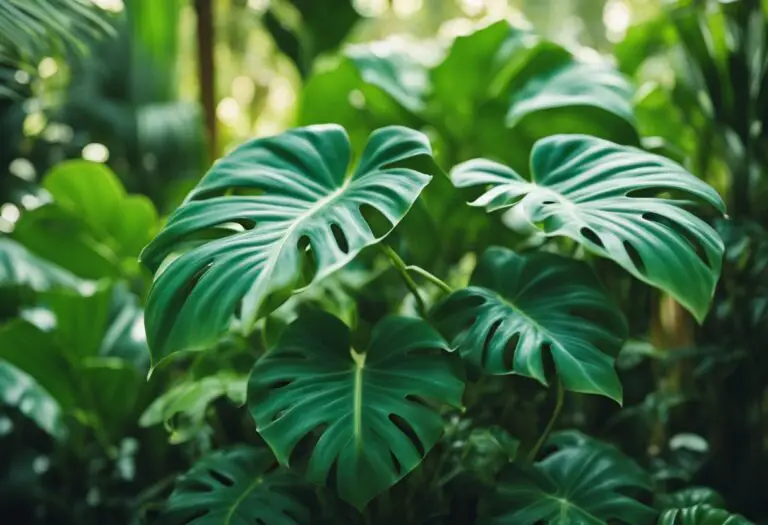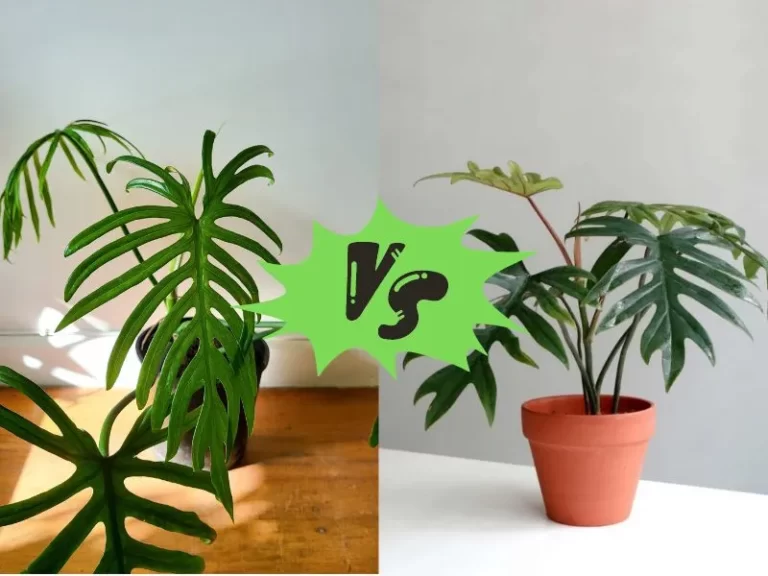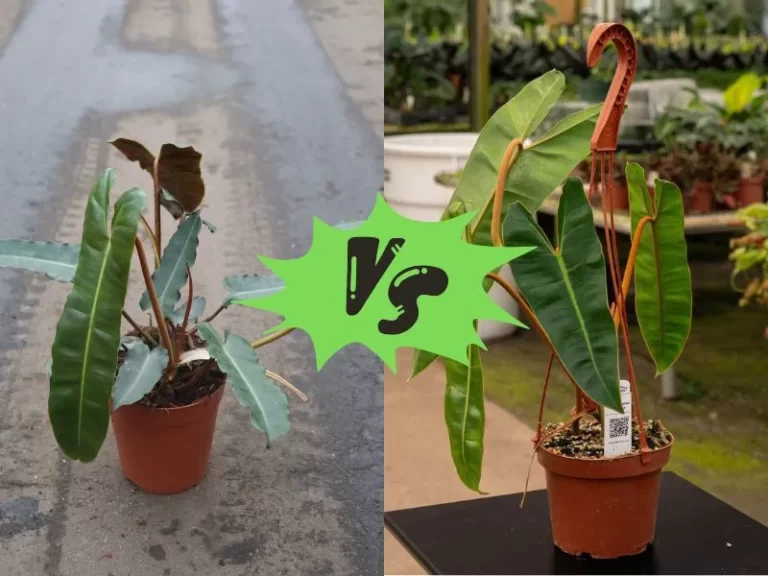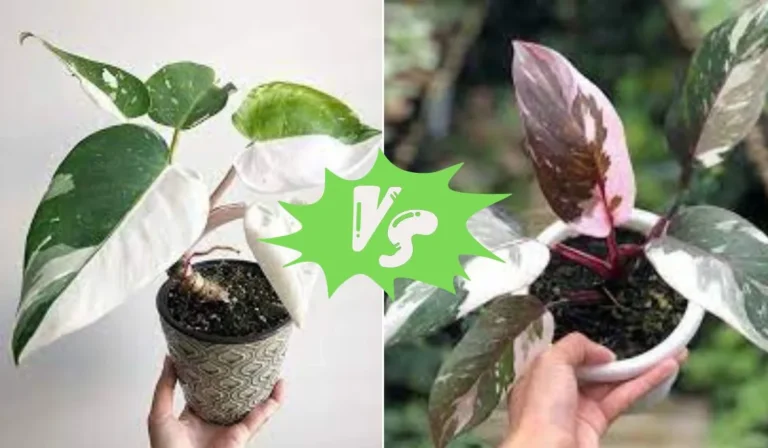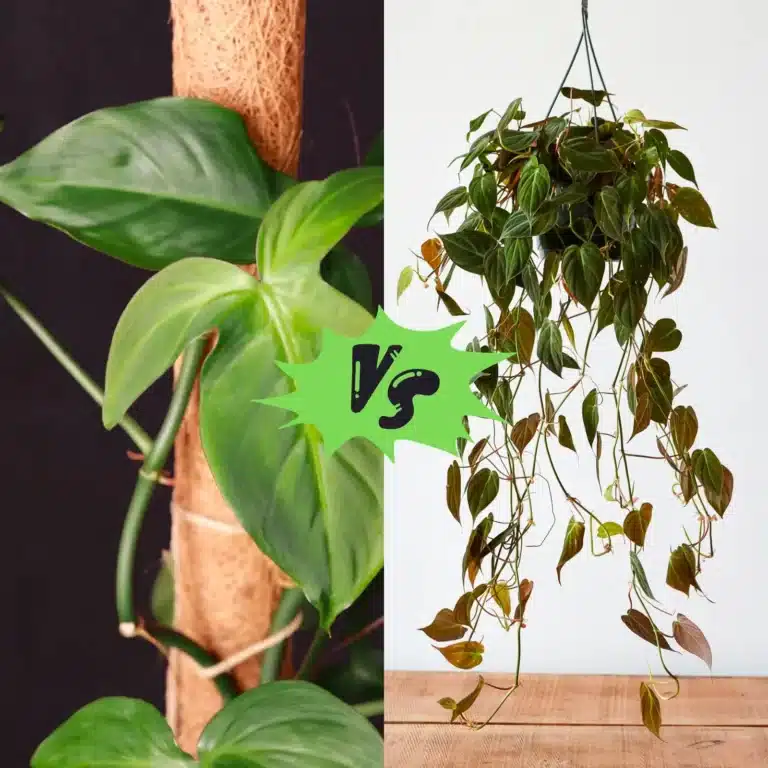Philodendron Imperial Green vs Congo Green: A Comparison of Two Popular Houseplants
New to gardening and want to bring some greenery into your home? Choosing between philodendron varieties like the Imperial Green and Congo Green? Let’s explore their key differences.

Philodendrons are popular tropical plants known for their large, glossy leaves and easy maintenance. The Imperial Green, a striking option, boasts deep green leaves and can reach up to three feet in height. Thriving in bright, indirect light, it’s a low-maintenance choice for indoor environments.
Whether you’re aiming for a statement piece or just getting started with indoor plants, understanding the distinctions between the Imperial Green and Congo Green is essential. Let’s dive in.
Key Takeaways
- Philodendrons are popular tropical plants known for their large, glossy leaves and ease of care.
- The Philodendron Imperial Green is a large-leafed plant that can grow up to three feet tall and prefers bright, indirect light.
- When choosing between the Imperial Green and Congo Green, consider the size and lighting requirements of each plant to find the best fit for your space.
Philodendron Imperial Green

Characteristics
The Philodendron Imperial Green is a popular indoor plant known for its lush, glossy green leaves that have a heart shape. It is a compact plant that can grow up to 3 feet tall, making it an excellent choice for smaller spaces.
The leaves of the Imperial Green are typically around 12 inches in length and 8 inches in width, providing a full and vibrant appearance. This variety of philodendron is often sought after for its ability to purify the air, making it a great addition to any indoor environment.
Care Requirements
When caring for the Philodendron Imperial Green, it’s essential to provide it with the right conditions to thrive. This plant prefers bright, indirect light, but it can also tolerate lower light conditions. Keep the soil consistently moist, but not waterlogged, and ensure that the plant is placed in a well-draining pot.
Regularly misting the leaves can help maintain the humidity levels that the plant enjoys. Fertilize the Imperial Green every 4-6 weeks during the growing season to encourage healthy growth.
Common Issues
While the Philodendron Imperial Green is relatively low-maintenance, it can still face a few common issues. Overwatering can lead to root rot, so it’s crucial to allow the soil to dry out slightly between waterings.
Additionally, the plant may attract pests such as spider mites or mealybugs, which can be addressed with insecticidal soap or neem oil. Keep an eye out for any yellowing or browning of the leaves, as this may indicate that the plant is receiving too much or too little water.
Philodendron Congo Green
If you’re looking for a plant that is easy to care for and adds a pop of green to your space, the Philodendron Congo Green is a great option. Here’s what you need to know about this popular houseplant:
Characteristics
The Philodendron Congo Green is a tropical plant that is native to South America. It is part of the Araceae family, which also includes other popular houseplants like the Monstera and Peace Lily. The plant has large, glossy leaves that can grow up to 2 feet long.
The leaves are a deep green color and have a slightly ruffled texture. The plant can grow up to 5 feet tall, which makes it a great choice for filling up empty corners in your home.
Care Requirements
The Philodendron Congo Green is a fairly easy plant to care for. Here are some tips to keep your plant healthy:
- Light: The plant does best in bright, indirect light. Avoid placing it in direct sunlight as this can burn the leaves.
- Watering: Water the plant when the top inch of soil feels dry to the touch. Be careful not to overwater the plant as this can lead to root rot.
- Humidity: The plant prefers high humidity, so consider using a humidifier or placing a tray of water near the plant to increase humidity levels.
- Soil: Use a well-draining potting mix that is rich in organic matter.
- Fertilizer: Fertilize the plant once a month during the growing season (spring and summer) with a balanced fertilizer.
Propagation Techniques
The Philodendron Congo Green can be propagated through stem cuttings. Here’s how to do it:
- Use a sharp, clean pair of scissors to cut a stem that is at least 6 inches long. Make the cut just below a node (where a leaf meets the stem).
- Remove the bottom leaves from the stem, leaving only one or two leaves at the top.
- Dip the cut end of the stem in rooting hormone powder.
- Plant the stem in a pot filled with moist potting mix.
- Cover the pot with a plastic bag to create a humid environment.
- Place the pot in bright, indirect light.
- Keep the soil moist but not waterlogged.
- After a few weeks, the stem should start to grow roots. You can then remove the plastic bag and treat the plant like a mature Philodendron Congo Green.
Overall, the Philodendron Congo Green is a great choice for anyone looking for a low-maintenance houseplant that adds a touch of tropical flair to their home. With the right care, this plant can thrive for years to come.
Comparative Analysis
When deciding between Philodendron Imperial Green and Congo Green, it can be difficult to know which one to choose.
Both plants have their own unique characteristics and care requirements. In this section, we will compare the two plants based on their appearance, growth habits, and care differences.
Appearance
Philodendron Imperial Green and Congo Green are both beautiful plants that can add a touch of elegance to any room. However, there are some differences in their appearance that can help you determine which plant is right for you.
- Philodendron Imperial Green has large, glossy leaves that are a deep green color. The leaves are heart-shaped and can grow up to 12 inches long and 8 inches wide. The stems of the plant are also green and can grow up to 3 feet long.
- Congo Green, on the other hand, has smaller leaves that are a lighter shade of green. The leaves are also heart-shaped but are more elongated than the leaves of Philodendron Imperial Green. The stems of Congo Green are reddish-brown in color and can grow up to 6 feet long.
Growth Habits
Both Philodendron Imperial Green and Congo Green are relatively easy to care for and can grow well in a variety of conditions. However, there are some differences in their growth habits that you should be aware of.
- Philodendron Imperial Green is a slow-growing plant that can take several years to reach its full size. It prefers bright, indirect light and should be kept in a well-draining potting mix. This plant can grow up to 3 feet tall and 3 feet wide.
- Congo Green is a faster-growing plant that can reach its full size in just a few years. It prefers bright, indirect light but can also tolerate low light conditions. This plant should be kept in a well-draining potting mix and can grow up to 6 feet tall and 3 feet wide.
Care Differences
While both Philodendron Imperial Green and Congo Green have similar care requirements, there are some differences that you should be aware of.
- Philodendron Imperial Green prefers to be kept in a humid environment and should be misted regularly. It should also be fertilized every two weeks during the growing season.
- Congo Green is more tolerant of dry air and does not need to be misted as often. It should be fertilized every four weeks during the growing season.
Choosing the Right Plant for Your Space
When deciding between Philodendron Imperial Green and Congo Green, it’s important to consider the needs of your space. Here are some factors to keep in mind:
Light Requirements
Both plants prefer bright, indirect light, but the Congo Green can tolerate lower light conditions better than the Imperial Green. If your space doesn’t receive much natural light, the Congo Green might be the better choice.
Size
The Imperial Green is a compact, bushy plant that grows to about 2-3 feet tall. The Congo Green, on the other hand, can grow up to 6 feet tall and has larger leaves. If you have a smaller space, the Imperial Green might be a better fit.
Care Requirements
Both plants are relatively easy to care for, but the Congo Green is more tolerant of neglect. If you’re new to plant care or don’t have a lot of time to devote to your plants, the Congo Green might be a better choice.
Appearance
The Imperial Green has smaller, more rounded leaves, while the Congo Green has larger, more elongated leaves. Both plants have a deep green color, but the Congo Green has a shiny, almost metallic look to its leaves.
Price
The Congo Green is generally more expensive than the Imperial Green, due to its larger size and more striking appearance. Keep this in mind when making your decision.
In summary, both the Philodendron Imperial Green and Congo Green are beautiful, easy-to-care-for plants that can add a touch of greenery to any space. When choosing between the two, consider factors such as light requirements, size, care requirements, appearance, and price to ensure you make the best choice for your space.
Frequently Asked Questions
What distinguishes the Philodendron Imperial Green from the Congo Green in terms of growth habits?
Philodendron Imperial Green and Congo Green are two popular varieties of philodendron. While both have similar growth habits, there are a few key differences.
The Philodendron Imperial Green is known for its bushy growth habit, while the Congo Green has a more upright growth habit. Additionally, the leaves of the Congo Green tend to be larger and more elongated than the Imperial Green.
Can you describe the care requirements for a Philodendron Imperial Green?
To keep your Philodendron Imperial Green healthy, you should aim to recreate its natural tropical environment as closely as possible. This means providing it with bright, indirect light, well-draining soil, and high humidity.
The Imperial Green prefers to be kept moist, but not waterlogged, so be sure to water it thoroughly when the top inch of soil feels dry. Fertilize your Philodendron Imperial Green every two to three months during the growing season with a balanced, water-soluble fertilizer.
What are the main visual differences between the Philodendron Imperial Green and the Congo Green?
The Philodendron Imperial Green and Congo Green have some distinct visual differences. The Imperial Green has rounder leaves with a slightly smaller size and a bushier growth habit.
On the other hand, the Congo Green has more elongated leaves with pronounced veins and a taller, more upright growth habit.
How large can I expect my Philodendron Imperial Green to grow?
The Philodendron Imperial Green can grow up to 3 feet tall and 3 feet wide, making it an excellent choice for filling up empty spaces in your home. However, the plant’s size will depend on the pot size, light, and humidity levels.
What tips can you share for successfully propagating a Philodendron Congo Green?
Propagating a Philodendron Congo Green is relatively easy. You can propagate it through stem cuttings or air layering. To propagate through stem cuttings, take a cutting from the plant’s stem, remove the lower leaves, and place the cutting in water or soil.
To propagate through air layering, make a small cut in the stem and wrap it with moist sphagnum moss. Cover the moss with plastic wrap and wait for roots to form. Once the roots have formed, cut the stem below the moss and plant it in soil.
Are there any common issues to look out for when caring for a Philodendron Green Princess?
Philodendron Imperial Green and Congo Green are relatively easy to care for, but they can suffer from a few common issues. Overwatering can lead to root rot, so be sure to let the soil dry out a bit between waterings.
Low humidity can cause the plant’s leaves to turn brown and dry out, so consider using a humidifier or placing a tray of water near the plant to increase humidity levels. Finally, be on the lookout for pests like spider mites and mealybugs, which can damage the plant’s leaves.

